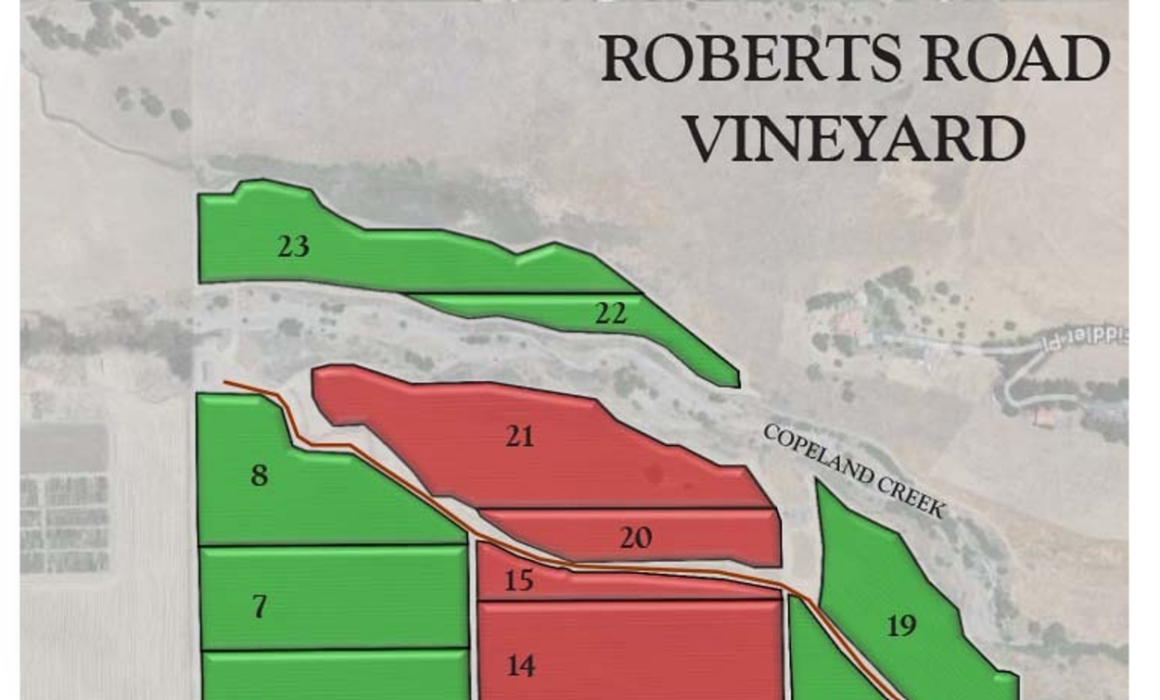At Roberts Road Vineyard, a Sangiacomo Passed the Torch to His Sons
By Virginie Boone
Mike and Steve Sangiacomo like to tell a story about how their dad, Angelo, didn’t have any hobbies. Instead, whenever he had free time away from the growing business that had become Sangiacomo Vineyards, he liked to drive around Sonoma County and see what was going on in local agriculture and sniff out opportunities.
This is how one day he ended up in Penngrove off Petaluma Hill Road to say hello to a man named Ed Grossi.
Grossi had grown up on a dairy ranch in West Marin, a 4-H and FFA kid. After Cal Poly he worked on a hay ranch and started a fertilizer business in Rohnert Park. Along Petaluma Hill Road, Grossi was working his 20-acre organic vegetable and fruit farm when Angelo Sangiacomo stumbled along in 1999.
There wasn’t much of a history of grapegrowing in this low-slung area and Sangiacomo had his doubts about a piece of land for sale nearby. The soils looked to be all heavy clay and so he figured that the land not yet planted near Grossi might not be great for wine grapes.
Still, he brought his sons out to do some digging. Getting to the site after a bout of rain, the Sangiacomos assumed they’d run into a sticky mess, but after digging 12 separate holes around the property, they didn’t run into clay once. Instead they got gravel and loam, not at all what they were expecting.
Situated at the base of Sonoma Mountain’s western slopes in the northern part of what is now the Petaluma Gap appellation, Grossi told the Sangiacomos that Copeland Creek, which runs across Roberts Road’s northern border, used to run across the site, leaving behind cobblestone and alluvium soils.
These rocky well-drained soils at Roberts Road Vineyard turned out to grow great grapes that ripen slowly in the fog. Spanning across 130 acres, the vineyard enjoys two watersheds, one draining into the Russian River and the other into San Pablo Bay.
After confirming the soils were balanced, the Sangiacomos bought the site and started thinking about planting.
“We called it the passing of the torch vineyard,” Steve Sangiacomo remembered.
Dad decided it would be up to Steve and his brother Mike to plant the Pinot Noir, Chardonnay and Merlot and pick out the rootstocks and clones. They ended up with 20 different clonal selection and rootstock combinations. Much still remains of the original 1999 planting (except for the Merlot, that’s long gone).
A pre-plant contract with Clos du Bois to buy Chardonnay helped them get going, making Roberts Road one of the first vineyards to be planted in what is now the Petaluma Gap AVA. Sojourn Cellars is its longest running winery buyer, sourcing Pinot Noir from Roberts Road since 2003, and credits the vineyard for giving it its start.
“It makes quintessential Pinot Noir,” winemaker Randy Bennett says. “Silky tannins, smooth texture.”
As for Grossi, he started Sweet Lane Wholesale Nursery in 2000 to grow specialty plants and one of the biggest collections of Japanese maples for landscaping projects (including at wineries) all over the Bay Area. In 2001 Grossi budded over that vegetable and fruit farm off Petaluma Hill Road near Roberts Road Vineyard to Pinot Noir.
Today he looks after 16 acres of Sweet Lane Vineyard Pinot Noir and Chardonnay grapes that he sells to Schramsberg to make sparkling wine and makes a tiny amount of wine of his own, mostly for friends.
Meanwhile, the Petaluma Gap AVA has become a highly sought-after area for grapes. In 2012, Gap’s Crown Vineyard just above Roberts Road became the first in Sonoma County to sell for more than $100,000/acre, and Roberts Roads Vineyard has become a marquee site for more than 30 wineries, with about 18 vineyard-designated wines claiming its name in both Chardonnay and Pinot Noir.
One of the most significant is the Sangiacomos’ own wine, made by winemaker James MacPhail, who says that every wine he’s made from Roberts Road Vineyard, beginning in 2003, showcases certain signatures of the site.
“There’s an elegance to the tannins, they’re always silky,” he says. “There’s an earth and fruit balance, the wines always fall in the middle.”
Jeff Gaffner of Saxon Brown makes nine different Pinot Noirs but calls his Roberts Road Pinot, “the most feminine and seductive of all of them.”
Other Roberts Road Vineyard wines to look for are being made by Adobe Road Winery, Anaba, Noria Wines and Westwood Wine. As for the future, the Sangiacomos plan to replant some of those older plantings over time, adding more Pinot Noir along the way.


